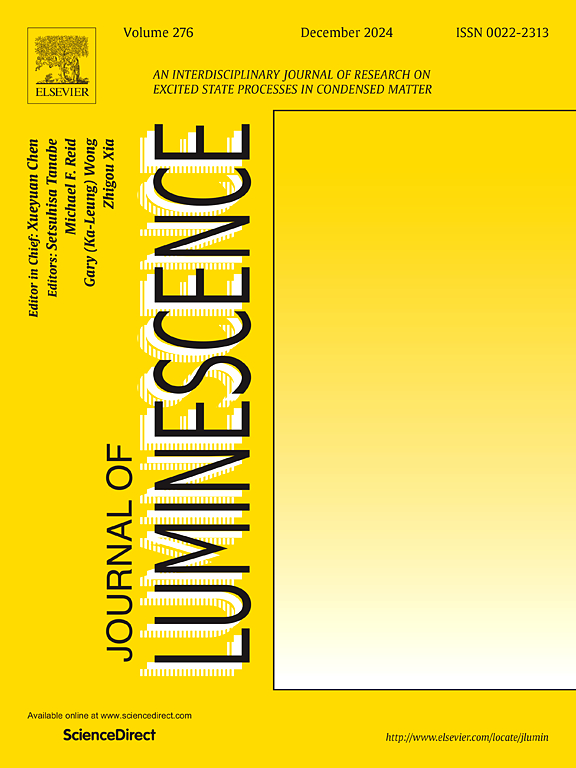Impacts of varied roughness in n-AlGaN surface for the optoelectronic performance of AlGaN based ultraviolet Mini-LEDs
IF 3.3
3区 物理与天体物理
Q2 OPTICS
引用次数: 0
Abstract
In this work, 300 × 300 μm2 AlGaN-based ultraviolet (UV) Mini-LEDs were fabricated on c-plane sapphire substrates. After removing the sapphire substrate and AlN buffer layer using the laser lift-off (LLO) technique, the exposed n-AlGaN surfaces were roughened through chemical etching with varying durations, resulting in four types of UV Mini-LEDs with different n-AlGaN surface roughness levels. The surface roughness of these n-AlGaN layers was characterized by using the scanning electron microscope (SEM) and atomic force microscopy (AFM) measurement. Electro-optical measurements demonstrated that surface roughening improved both the light extraction efficiency (LEE) and external quantum efficiency (EQE) of the UV Mini-LEDs. To further explore the physical mechanisms underlying the LEE enhancement in devices with varied surface roughness levels, the finite-difference time-domain (FDTD) simulations were adopted. Additionally, the results of surface temperature distribution also indicated that the increased surface roughness could improve the thermal performance of devices. Notably, prolonged roughening treatment duration was observed to adversely affect the forward voltage characteristics of Mini-LEDs, indicating the necessity for proper surface roughening processes to balance luminous efficiency and electrical performance during device fabrication.
n-AlGaN表面粗糙度对基于AlGaN的紫外迷你led光电性能的影响
在c面蓝宝石衬底上制备了300 × 300 μm2的algan基紫外(UV) mini - led。在使用激光提升(LLO)技术去除蓝宝石衬底和AlN缓冲层后,通过不同持续时间的化学蚀刻对暴露的n-AlGaN表面进行粗糙度处理,得到四种不同n-AlGaN表面粗糙度水平的UV mini - led。利用扫描电子显微镜(SEM)和原子力显微镜(AFM)对n-AlGaN层的表面粗糙度进行了表征。电光测量表明,表面粗化提高了UV mini - led的光提取效率(LEE)和外量子效率(EQE)。为了进一步探索不同表面粗糙度器件中LEE增强的物理机制,采用时域有限差分(FDTD)模拟。此外,表面温度分布的结果也表明,增加表面粗糙度可以改善器件的热性能。值得注意的是,延长的粗化处理时间会对mini - led的正向电压特性产生不利影响,这表明在器件制造过程中,需要适当的表面粗化处理来平衡发光效率和电性能。
本文章由计算机程序翻译,如有差异,请以英文原文为准。
求助全文
约1分钟内获得全文
求助全文
来源期刊

Journal of Luminescence
物理-光学
CiteScore
6.70
自引率
13.90%
发文量
850
审稿时长
3.8 months
期刊介绍:
The purpose of the Journal of Luminescence is to provide a means of communication between scientists in different disciplines who share a common interest in the electronic excited states of molecular, ionic and covalent systems, whether crystalline, amorphous, or liquid.
We invite original papers and reviews on such subjects as: exciton and polariton dynamics, dynamics of localized excited states, energy and charge transport in ordered and disordered systems, radiative and non-radiative recombination, relaxation processes, vibronic interactions in electronic excited states, photochemistry in condensed systems, excited state resonance, double resonance, spin dynamics, selective excitation spectroscopy, hole burning, coherent processes in excited states, (e.g. coherent optical transients, photon echoes, transient gratings), multiphoton processes, optical bistability, photochromism, and new techniques for the study of excited states. This list is not intended to be exhaustive. Papers in the traditional areas of optical spectroscopy (absorption, MCD, luminescence, Raman scattering) are welcome. Papers on applications (phosphors, scintillators, electro- and cathodo-luminescence, radiography, bioimaging, solar energy, energy conversion, etc.) are also welcome if they present results of scientific, rather than only technological interest. However, papers containing purely theoretical results, not related to phenomena in the excited states, as well as papers using luminescence spectroscopy to perform routine analytical chemistry or biochemistry procedures, are outside the scope of the journal. Some exceptions will be possible at the discretion of the editors.
 求助内容:
求助内容: 应助结果提醒方式:
应助结果提醒方式:


